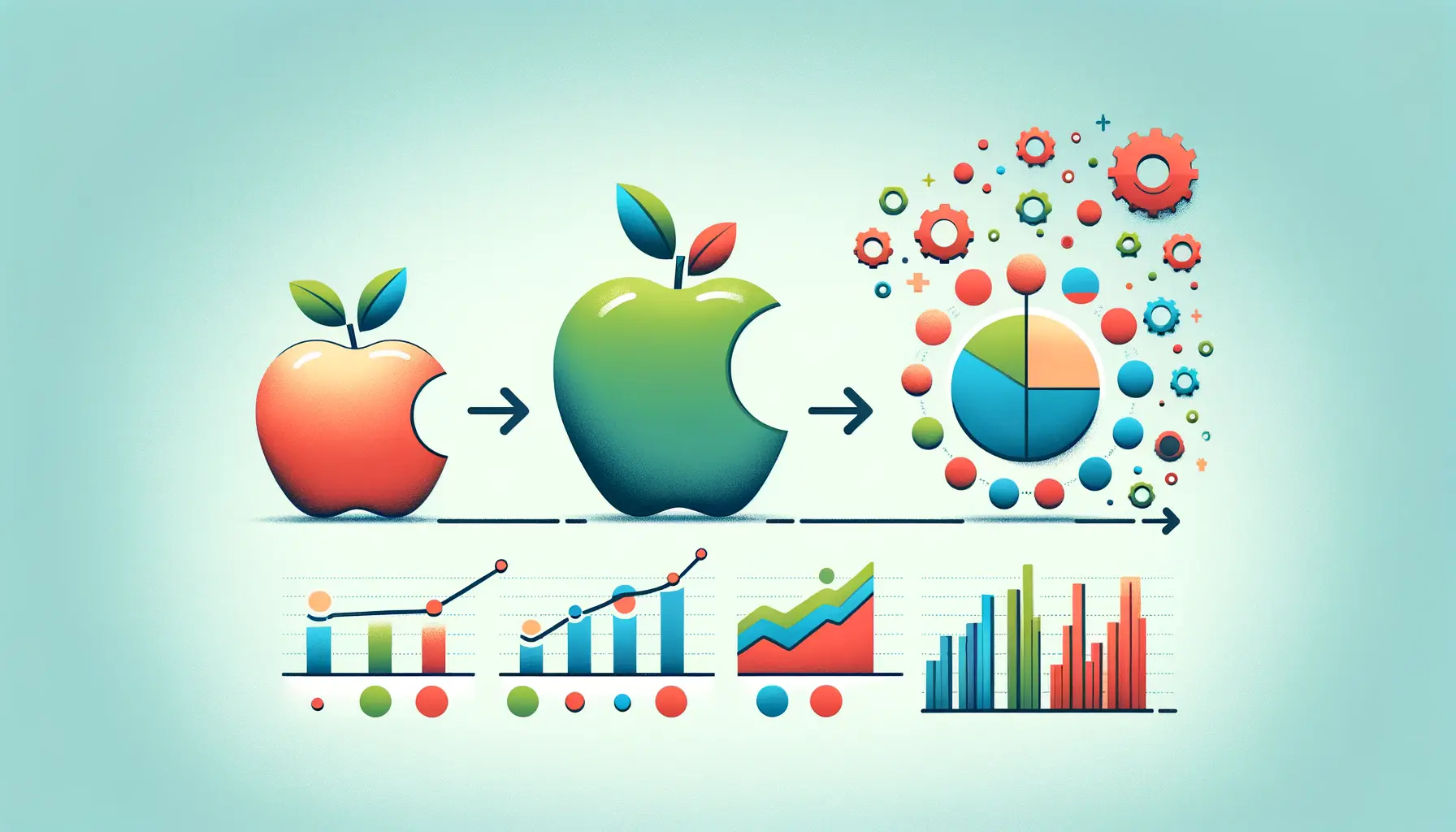In the rapidly evolving landscape of digital advertising, one of the most pressing hurdles that marketers face is accurately measuring the impact of their campaigns.
With the advent of Apple Search Ads and similar platforms, the complexity of ad measurement has significantly increased.
This article delves into the multifaceted world of ad measurement challenges, offering insights and strategies to navigate these obstacles effectively.
The digital advertising realm is in a constant state of flux, with new technologies and platforms emerging at a breakneck pace.
Amidst this dynamic environment, advertisers are grappling with the task of tracking and analyzing the performance of their ads across various channels.
The core of the issue lies in the diverse nature of digital platforms, each with its own set of metrics and measurement methodologies, making it increasingly difficult to obtain a holistic view of campaign performance.
- The Evolution of Ad Measurement
- Integrating Cross-Platform Measurement
- Emphasizing Outcome-Based Metrics
- Leveraging Technology for Enhanced Measurement
- Optimizing Strategies with Real-Time Data
- Future Trends in Ad Measurement
- Building a Comprehensive Ad Measurement Framework
- Mastering Ad Measurement Challenges in the Digital Era
- FAQs on Navigating Ad Measurement Challenges
The Evolution of Ad Measurement
From Impressions to Impact
Ad measurement has come a long way from the days of counting impressions and clicks.
Today, advertisers seek to understand the real impact of their ads on consumer behavior and sales.
This shift towards outcome-based measurement reflects a growing recognition of the need for more sophisticated metrics that capture the nuances of consumer engagement and conversion.
However, this evolution brings its own set of challenges.
The proliferation of digital channels means that consumers interact with ads in a myriad of ways, across different devices and platforms.
Tracking these interactions and attributing them accurately to specific campaigns requires advanced analytics tools and a deep understanding of the customer journey.
Addressing Privacy Concerns
The increasing emphasis on privacy, highlighted by regulations such as GDPR and CCPA, adds another layer of complexity to ad measurement.
Advertisers must now navigate the delicate balance between gathering insightful data and respecting consumer privacy.
This has led to the rise of privacy-centric measurement approaches, which aim to provide valuable insights without compromising user data.
One such approach is the use of aggregated and anonymized data, which allows advertisers to glean insights into campaign performance without accessing personally identifiable information.
While this method offers a way forward in the privacy-conscious landscape, it also requires advertisers to adapt their strategies to work with less granular data.
The key to navigating ad measurement challenges lies in embracing new technologies and methodologies that respect consumer privacy while delivering actionable insights.
Integrating Cross-Platform Measurement
The digital advertising ecosystem is fragmented, with consumers engaging with content across multiple devices and platforms.
This fragmentation poses a significant challenge for advertisers striving to measure the effectiveness of their campaigns cohesively.
To tackle this, integrating cross-platform measurement tools has become essential.
These tools allow advertisers to track user interactions with ads, whether they’re on a mobile app, a web browser, or a connected TV, providing a unified view of campaign performance.
Effective cross-platform measurement hinges on the ability to:
- Identify and track users across devices and platforms without infringing on privacy.
- Aggregate data from various sources to create a comprehensive picture of campaign reach and impact.
- Apply consistent metrics across all channels to ensure comparability of data.
Challenges in Cross-Platform Measurement
Despite the availability of sophisticated tools, several hurdles remain in achieving accurate cross-platform measurement:
- Data Silos: Each platform often operates within its own ecosystem, making it difficult to consolidate data for a holistic analysis.
- Privacy Regulations: Stricter privacy laws complicate the tracking of users across platforms, requiring advertisers to find non-invasive methods of measurement.
- Varying Metrics: The lack of standardized metrics across platforms can lead to inconsistencies in data interpretation and campaign evaluation.
To navigate these challenges, advertisers are increasingly turning to advanced analytics solutions that leverage machine learning and artificial intelligence.
These technologies can process vast amounts of data from diverse sources, identifying patterns and insights that human analysts might miss.
Moreover, they offer the potential to predict campaign performance across platforms, enabling advertisers to optimize their strategies in real-time.
Embracing advanced analytics and AI is crucial for overcoming the complexities of cross-platform measurement, offering a path to more effective and efficient ad campaigns.
Emphasizing Outcome-Based Metrics
In the quest to prove the ROI of digital advertising campaigns, the focus has shifted towards outcome-based metrics.
These metrics, such as conversion rates, sales lift, and customer lifetime value, offer a more direct correlation to business objectives than traditional metrics like impressions or click-through rates.
By prioritizing outcomes, advertisers can allocate their budgets more effectively, investing in channels and strategies that deliver tangible results.
Implementing outcome-based measurement involves several key steps:
- Defining clear, measurable objectives that align with overall business goals.
- Identifying the specific actions or outcomes that will be tracked as indicators of success.
- Utilizing advanced tracking and analytics tools to measure these outcomes across all touchpoints in the customer journey.
Overcoming Obstacles to Outcome Measurement
While outcome-based measurement offers significant advantages, it also presents challenges:
- Attribution Complexity: Accurately attributing outcomes to specific ads or campaigns can be difficult, especially in multi-channel marketing strategies.
- Long Sales Cycles: For products or services with long consideration phases, connecting advertising efforts to final sales requires sophisticated tracking and analysis over extended periods.
- Data Integration: Combining data from various sources to measure outcomes necessitates robust data management and integration capabilities.
Advertisers can address these challenges by adopting a multi-touch attribution model, which accounts for the various touchpoints a consumer interacts with before making a purchase.
Additionally, integrating CRM and sales data with advertising analytics enables a more accurate measurement of how ad spend influences customer behavior and business outcomes.
True success in digital advertising is measured not just by visibility, but by the real-world impact of ads on consumer behavior and business results.
Leveraging Technology for Enhanced Measurement
The rapid advancement of technology has provided advertisers with new tools and methodologies to tackle ad measurement challenges.
From sophisticated analytics platforms to AI-driven insights, leveraging technology is key to enhancing the accuracy and efficiency of ad measurement.
These technologies not only streamline data collection and analysis but also offer predictive capabilities to forecast campaign performance and optimize strategies in real-time.
Key technological advancements impacting ad measurement include:
- Artificial Intelligence and Machine Learning for predictive analytics and pattern recognition.
- Blockchain for transparent and verifiable tracking of ad delivery and engagement.
- Data Management Platforms (DMPs) for aggregating and analyzing consumer data from multiple sources.
Breaking Down Technological Barriers
Despite the potential of these technologies to revolutionize ad measurement, several barriers can impede their adoption:
- Complexity and Cost: Implementing advanced technologies requires significant investment in tools and talent, which may be prohibitive for smaller advertisers.
- Data Privacy: Utilizing consumer data for enhanced measurement must be balanced with the need to protect privacy and comply with regulations.
- Integration Challenges: Integrating new technologies with existing marketing stacks can be complex and time-consuming.
To overcome these barriers, advertisers should focus on building partnerships with technology providers that offer scalable and flexible solutions.
Additionally, adopting a privacy-first approach to data collection and analysis will ensure compliance with regulations and maintain consumer trust.
Finally, a phased approach to technology integration can help manage complexity and minimize disruption to existing operations.
Adopting new technologies for ad measurement requires careful planning and execution but can significantly enhance the effectiveness of digital advertising campaigns.
Optimizing Strategies with Real-Time Data
The ability to access and analyze real-time data has transformed the landscape of digital advertising, enabling advertisers to optimize their strategies with unprecedented speed and precision.
Real-time data provides insights into how ads are performing at any given moment, allowing for quick adjustments to maximize effectiveness and ROI.
This dynamic approach to ad measurement and optimization can significantly improve campaign performance, but it requires a robust technological infrastructure and a proactive management strategy.
Key benefits of utilizing real-time data in ad measurement include:
- Immediate insights into campaign performance, enabling rapid adjustments to targeting, messaging, and budget allocation.
- Enhanced understanding of consumer behavior and preferences, allowing for more personalized and effective advertising.
- Increased agility in responding to market trends and competitive pressures.
Navigating the Challenges of Real-Time Data
While the advantages of real-time data are clear, several challenges must be addressed to fully leverage its potential:
- Data Volume and Velocity: Managing the vast amounts of data generated in real-time can be overwhelming, requiring advanced data processing and analytics capabilities.
- Accuracy and Relevance: Ensuring the data used for real-time optimization is accurate and relevant is crucial for making informed decisions.
- Resource Intensity: Maintaining a real-time data analysis and optimization process can be resource-intensive, demanding continuous attention and expertise.
To effectively utilize real-time data, advertisers should invest in scalable data analytics platforms that can process large volumes of data quickly and accurately.
Additionally, establishing a dedicated team to monitor and analyze real-time data can help ensure that insights are acted upon promptly.
Finally, integrating real-time data with longer-term analysis and strategic planning can provide a more comprehensive view of campaign performance and inform future strategies.
Real-time data offers a powerful tool for ad optimization, but its full potential can only be realized with the right technology, processes, and expertise in place.
Future Trends in Ad Measurement
The landscape of digital advertising is continuously evolving, with new trends and technologies shaping the future of ad measurement.
As advertisers seek more accurate and meaningful ways to assess the impact of their campaigns, several key trends are emerging that promise to redefine the standards of measurement in the digital age.
Staying ahead of these trends is crucial for advertisers aiming to maintain a competitive edge and drive better outcomes through their digital marketing efforts.
Emerging trends in ad measurement include:
- Increased reliance on first-party data as privacy concerns and regulations limit the use of third-party cookies.
- The rise of contextual advertising, leveraging AI to place ads in relevant content environments without relying on personal data.
- Greater emphasis on measuring ad effectiveness through consumer engagement and sentiment analysis, beyond traditional click and conversion metrics.
Adapting to a Cookieless Future
One of the most significant shifts in digital advertising is the move towards a cookieless future.
This change is driving advertisers to explore alternative methods for tracking and measuring ad performance.
First-party data, collected directly from consumers with their consent, is becoming increasingly valuable.
Advertisers are also turning to technology solutions like universal IDs and blockchain to ensure accurate and privacy-compliant measurement.
Moreover, the focus on contextual advertising is gaining momentum.
By analyzing the content that consumers are engaging with, advertisers can place ads in the most relevant and effective environments.
This approach not only respects consumer privacy but also enhances the relevance and impact of ads, leading to improved campaign performance.
Embracing Engagement and Sentiment Analysis
Another trend gaining traction is the shift towards measuring ad effectiveness based on consumer engagement and sentiment.
This involves analyzing how consumers interact with ads and the emotions they evoke.
Tools and platforms that can measure these qualitative aspects of consumer response are becoming essential for advertisers seeking to understand the true impact of their campaigns.
Engagement metrics, such as time spent with an ad, social shares, and comments, provide insights into how compelling and relevant an ad is to its audience.
Sentiment analysis, on the other hand, helps advertisers gauge the emotional resonance of their ads, offering clues on how to refine messaging for greater impact.
The future of ad measurement lies in leveraging advanced technologies and methodologies to gain deeper insights into consumer behavior and campaign effectiveness. Advertisers who embrace these trends will be better positioned to optimize their digital marketing strategies and achieve their business objectives.
Building a Comprehensive Ad Measurement Framework
As the digital advertising landscape becomes increasingly complex, developing a comprehensive ad measurement framework is essential for advertisers seeking to maximize the impact of their campaigns.
This framework should encompass a variety of metrics and methodologies, tailored to the unique objectives of each campaign and the broader goals of the organization.
By adopting a holistic approach to ad measurement, advertisers can ensure they are capturing the full spectrum of campaign performance and gaining the insights needed to drive continuous improvement.
Components of a comprehensive ad measurement framework include:
- Clear definition of campaign objectives and the key performance indicators (KPIs) that will be used to measure success.
- Integration of cross-platform measurement tools to track and analyze consumer interactions across all digital touchpoints.
- Utilization of advanced analytics and AI to process data and extract actionable insights.
- Emphasis on privacy-compliant data collection and analysis methods to protect consumer information and ensure regulatory compliance.
- Regular review and optimization of measurement strategies based on evolving technologies, consumer behaviors, and market trends.
Customizing Measurement Strategies
Given the diversity of digital advertising channels and the varying objectives of different campaigns, customizing measurement strategies is crucial.
This involves selecting the most relevant metrics and tools for each campaign, based on factors such as the target audience, the type of content being promoted, and the desired outcomes.
For example, a brand awareness campaign might prioritize reach and frequency metrics, while a direct response campaign focuses on conversion rates and ROI.
Moreover, the framework should be flexible enough to adapt to new measurement technologies and methodologies as they emerge.
Staying abreast of industry developments and continuously refining the measurement approach will enable advertisers to remain competitive and achieve better results from their digital advertising efforts.
Ensuring Actionable Insights
The ultimate goal of any ad measurement framework is to provide actionable insights that can inform future campaign strategies.
This requires not only accurate and comprehensive data collection but also effective analysis and interpretation of that data.
Advertisers should focus on translating measurement outcomes into practical recommendations for optimizing campaign performance, from adjusting targeting criteria and creative content to reallocating budgets across channels.
By building a comprehensive ad measurement framework, advertisers can navigate the complexities of the digital advertising landscape with confidence.
This approach enables them to accurately assess the effectiveness of their campaigns, make data-driven decisions, and continuously improve their advertising strategies to better meet the needs of their audience and achieve their business objectives.
A well-constructed ad measurement framework is the foundation of successful digital advertising, providing the insights needed to optimize campaigns and drive meaningful business results.
Mastering Ad Measurement Challenges in the Digital Era
In the rapidly evolving digital advertising landscape, mastering ad measurement challenges is not just an option but a necessity for advertisers aiming to optimize their campaigns and achieve substantial ROI.
The journey through understanding and navigating ad measurement complexities reveals a multifaceted challenge that encompasses integrating cross-platform measurement, emphasizing outcome-based metrics, leveraging technology, and much more.
As we’ve explored, each aspect of ad measurement offers unique challenges but also presents opportunities for innovation and growth.
Key Takeaways for Advertisers
Advertisers must embrace a holistic approach to ad measurement, one that incorporates real-time data, predictive analytics, and a deep understanding of consumer behavior.
The future of ad measurement, characterized by a cookieless world and an increased emphasis on privacy, demands a shift towards more sophisticated and compliant measurement strategies.
Advertisers who anticipate and adapt to these changes will not only navigate ad measurement challenges more effectively but will also set new benchmarks for success in digital advertising.
Strategies for Success
- Invest in cross-platform measurement tools to gain a unified view of campaign performance.
- Focus on outcome-based metrics that align closely with business objectives.
- Leverage the latest technologies, including AI and machine learning, for deeper insights and predictive analytics.
- Adopt privacy-compliant data collection methods to build trust with consumers and ensure regulatory compliance.
- Stay agile and adaptable, ready to refine strategies based on real-time data and evolving market trends.
The path to mastering ad measurement challenges is continuous and requires a commitment to learning, innovation, and strategic flexibility.
By focusing on these key strategies, advertisers can unlock the full potential of their digital campaigns, driving not just visibility but meaningful engagement and conversions.
The future of ad measurement is bright for those prepared to navigate its complexities, armed with the right tools, technologies, and a consumer-centric approach.
If you're seeking expertise in Apple Search Ads campaigns, visit our service page for professional management!
FAQs on Navigating Ad Measurement Challenges
Delve into the complexities of ad measurement with these frequently asked questions, offering insights to navigate the evolving landscape effectively.
Common challenges include data fragmentation, privacy regulations, integrating cross-platform data, and attributing sales accurately to specific ads or campaigns.
By prioritizing first-party data collection, adopting privacy-compliant tracking technologies, and ensuring transparency with consumers about data usage.
It provides a holistic view of campaign performance across all consumer touchpoints, essential for optimizing ad spend and improving ROI.
Advanced analytics, AI, and machine learning are pivotal for processing large data sets, predicting campaign performance, and offering actionable insights.
Real-time data allows for immediate campaign adjustments, improving targeting, messaging, and overall ad effectiveness.
Shifts towards first-party data, contextual advertising, and measuring consumer engagement and sentiment will significantly influence future ad measurement strategies.
Advertisers must explore alternative tracking methods, such as universal IDs and contextual targeting, to accurately measure ad performance without relying on cookies.
Outcome-based metrics align closely with business objectives, offering a more direct measure of an ad campaign’s impact on consumer behavior and sales.













